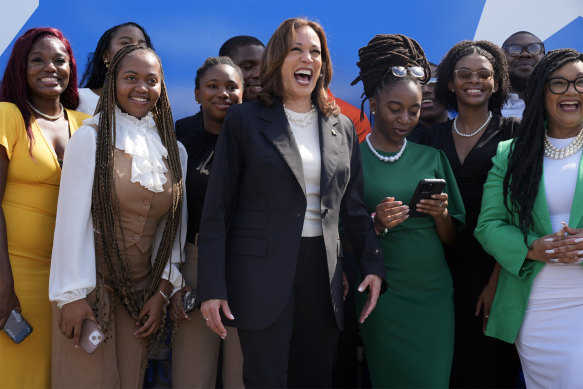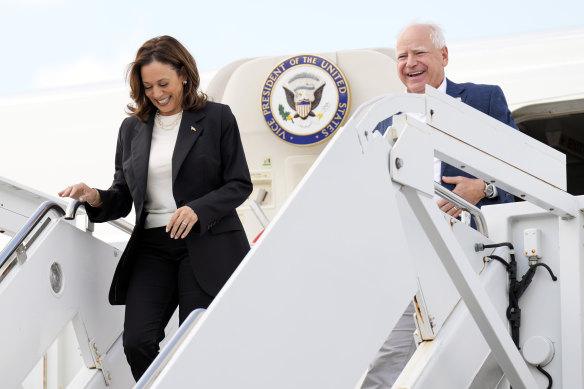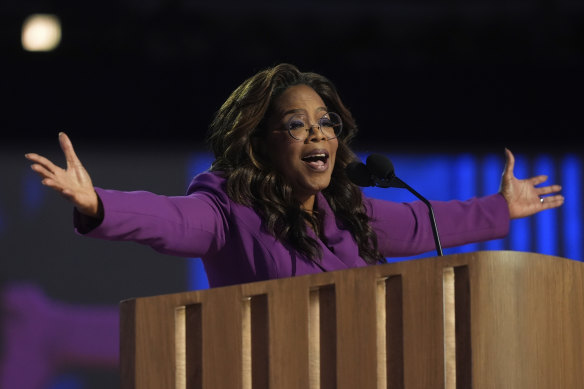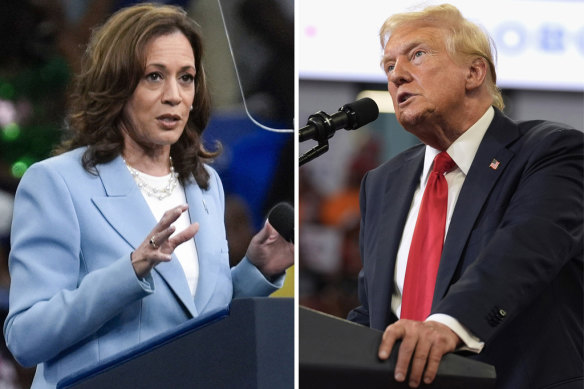This was published 9 months ago
Opinion
Kamala Harris is off to a Deep South Republican stronghold. So am I
Farrah Tomazin
Former North America correspondentWhat in the World, a free weekly newsletter from our foreign correspondents, is sent every Thursday. Below is an excerpt. Sign up to get the whole newsletter delivered to your inbox.
Hello from Washington,
I’m writing this from Reagan National Airport as I wait to board a plane to Georgia, the Deep South state that helped propel US President Joe Biden to victory four years ago.

Democratic presidential nominee Vice President Kamala Harris greets supporters on arrival at the Savannah/Hilton Head International Airport in Savannah, Georgia.Credit: AP
Until Donald Trump narrowly lost Georgia by fewer than 12,000 votes at the 2020 election, it had been one of the safest Republican strongholds in the country, with no Democratic presidential candidate securing victory there since Bill Clinton in 1992.
Kamala Harris is now hoping the so-called Peach State also swings her way. She is embarking on a two-day bus tour through urban, rural and suburban communities with her running mate, Tim Walz, a trip that will culminate in a rally in the historic coastal city of Savannah on Thursday evening (Friday AEST).
That Harris and Walz are heading to Georgia for their first burst of campaigning since last week’s Democratic National Convention says a lot about how much the race for the White House has changed since Biden suspended his campaign for re-election last month.

Harris and Democratic vice presidential candidate Minnesota Governor Tim Walz arrive in the state of Georgia.Credit: AP
Until then, most of the Democratic insiders I spoke to conceded that the “sun belt” – the fast-growing and diverse states of Georgia, Arizona, Nevada and North Carolina – were breaking Trump’s way, and the party should instead focus its attention on the crucial “rust belt” battlegrounds of Pennsylvania, Wisconsin and Michigan.
Now, as polls suggest, all seven states are very much in play.
Whatever one thinks of Harris, it is astonishing to see how quickly her elevation to the top of the Democratic ticket has transformed the 2024 election. According to her campaign, she has raised more than $US540 million ($795 million) worth of donations in just over a month – including $US82 million during the convention in Chicago last week.
Hundreds of thousands of volunteers have signed up to join the Harris-Walz campaign, including 90,000 last Thursday and Friday alone after the vice president hit the stage to formally accept her presidential nomination.
The atmosphere inside the United Centre was truly electric – even exceeding the giddy enthusiasm of the Republican National Convention a few weeks earlier, when emboldened delegates rallied around Trump after the attempted assassination on him.
Indeed, from the moment DJ Cassidy hit the decks in Chicago for the ceremonial roll call – paving the way for an unforgettable cameo by US rapper Lil Jon as Georgia cast its votes – democracy became an unbridled celebration.
Jubilant Democrats danced and cheered in their seats. People waved the American flag and chanted “USA! USA!” – the kind of patriotism you’d expect to see at a Trump rally.
The roar of the crowd was at times deafening, most notably when Michelle Obama, Hillary Clinton and Oprah Winfrey took the stage to deliver three of the best speeches of the convention.

Oprah at the Democratic National Convention Credit: AP
“Let us choose joyyyyyyyyyyyyy!” Winfrey sang on the third night, using what has fast become the buzzword of the election.
And that they did. But what strikes me about this stunning turnaround is that it is less about Harris herself – whom most Americans are still getting to know – and more about voters’ immense dissatisfaction with the prospect of a Trump-Biden rematch.
This is something I saw first-hand, over and over, as I travelled around battleground states this year. In South Carolina, for instance, I met former Democrat Chris Salley, who left the party last October outraged by Biden’s stance over the war in Gaza.
In North Carolina, university student Alexander Denza expressed similar frustrations, adding that “the fact that we have more of the same or the status quo is tiring students out”.
And in New Hampshire, Kris Make cast her vote in the Democratic primaries for Biden’s longshot challenger, Dean Phillips, due to fears about the president’s age and ability to do the job.
Harris’ ascension has offered these kinds of voters what they had been longing for: something new, different and younger than the two “pale, male, and stale” candidates they had to choose from four years ago.
The big question is whether Harris can sustain the momentum. With just over two months until election day, the latest RealClearPolitics poll of averages has Harris leading Trump at a national level, 48.3 per cent to 46.6 per cent.

Polls have moved against Trump since Harris replaced Biden as the Democratic nominee.Credit: nna\Jorgebranco
But when you drill down to individual battleground states, the race remains extremely tight, with Trump very narrowly ahead in Arizona, Pennsylvania, North Carolina, Georgia and Nevada, and Harris with a small edge in Wisconsin and Michigan.
Her first post-convention test will come on Thursday night when the often-scripted vice president finally sits down for a proper interview on CNN, alongside running mate Tim Walz.
A much bigger test, however, will take place on September 10, when she goes head-to-head with Trump in their first presidential debate in Philadelphia.
Expect a bare-knuckled brawl between a former prosecutor and a convicted felon, where anything could happen to upend the race. Just ask Biden.
Until next time,
Farrah.
Get a note directly from our foreign correspondents on what’s making headlines around the world. Sign up for the weekly What in the World newsletter here.